Tableau
Tableau is a visual analytics platform transforming the way we use data to solve problems—empowering people and organizations to make the most of their data. By leveraging the databend-jdbc driver (version 0.3.4 or higher), both Databend and Databend Cloud can integrate with Tableau, enabling seamless data access and efficient analysis. It is important to note that for optimal compatibility, it is advisable to use Tableau version 2022.3 or higher to avoid potential compatibility issues.
Databend currently provides two integration methods with Tableau. The first approach utilizes the Other Databases (JDBC) interface within Tableau and is applicable to both Databend and Databend Cloud. The second method recommends using the databend-tableau-connector-jdbc connector specifically developed by Databend for optimal connectivity with Databend.
The databend-tableau-connector-jdbc connector offers faster performance through its JDBC driver, especially when creating Extracts, and is easier to install as a cross-platform jar file, eliminating platform-specific compilations. It allows you to fine-tune SQL queries for standard Tableau functionality, including multiple JOINS and working with Sets, and provides a user-friendly connection dialog for a seamless integration experience.
Tutorial-1: Integrating with Databend (through Other Databases (JDBC) Interface)
In this tutorial, you'll deploy and integrate a local Databend with Tableau Desktop. Before you start, download Tableau Desktop and follow the on-screen instructions to complete the installation.
Step 1. Deploy Databend
- Follow the Local and Docker Deployments guide to deploy a local Databend.
- Create a SQL user in Databend. You will use this account to connect to Databend in Tableau Desktop.
CREATE USER tableau IDENTIFIED BY 'tableau';
GRANT ALL ON *.* TO tableau;
Step 2. Install databend-jdbc
-
Download the databend-jdbc driver (version 0.3.4 or higher) from the Maven Central Repository at https://repo1.maven.org/maven2/com/databend/databend-jdbc/
-
To install the databend-jdbc driver, move the jar file (for example, databend-jdbc-0.3.4.jar) to Tableau's driver folder. Tableau's driver folder varies depending on the operating system:
| Operating System | Tableau's Driver Folder |
|---|---|
| MacOS | ~/Library/Tableau/Drivers |
| Windows | C:\Program Files\Tableau\Drivers |
Step 3. Connect to Databend
- Launch Tableau Desktop and select Other Database (JDBC) in the sidebar. This opens a window as follows:
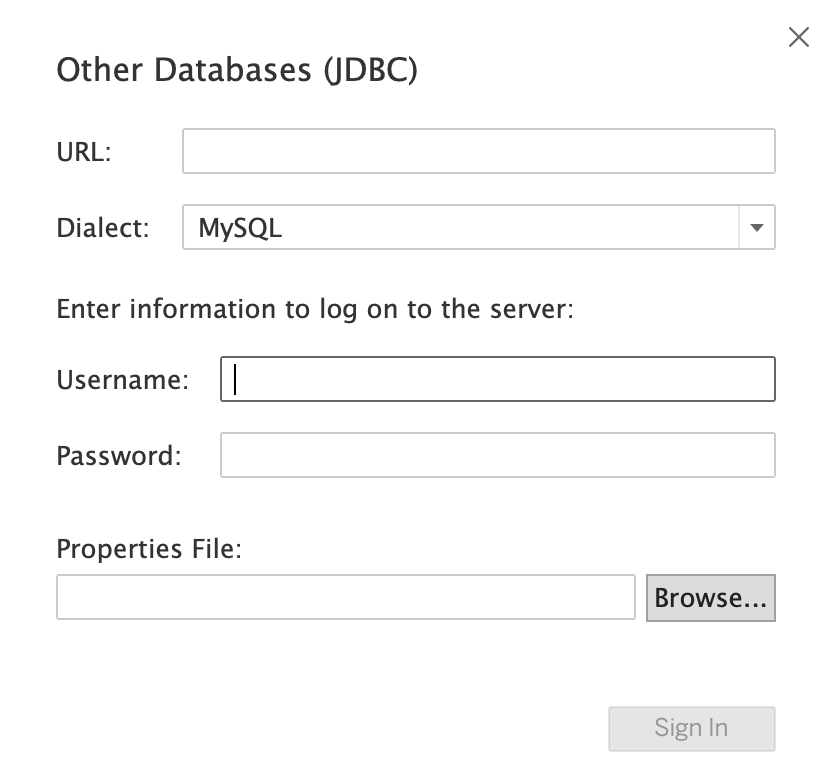
- In the window that opens, provide the connection information and click Sign In.
| Parameter | Description | For This Tutorial |
|---|---|---|
| URL | Format: jdbc:databend://{user}:{password}@{host}:{port}/{database} | jdbc:databend://tableau:tableau@127.0.0.1:8000/default |
| Dialect | Select "MySQL" for SQL dialect. | MySQL |
| Username | SQL user for connecting to Databend | tableau |
| Password | SQL user for connecting to Databend | tableau |
- When the Tableau workbook opens, select the database, schema, and tables that you want to query. For this tutorial, select default for both Database and Schema.
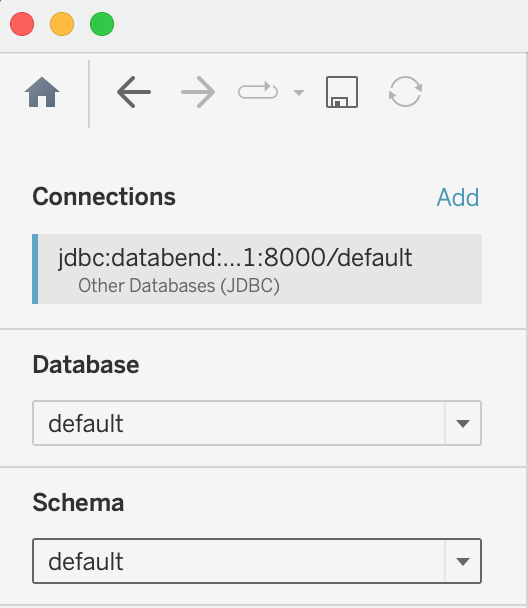
You're all set! You can now drag tables to the work area to start your query and further analysis.
Tutorial-2: Integrating with Databend (through databend-tableau-connector-jdbc Connector)
In this tutorial, you'll deploy and integrate a local Databend with Tableau Desktop. Before you start, download Tableau Desktop and follow the on-screen instructions to complete the installation.
Step 1. Deploy Databend
- Follow the Local and Docker Deployments guide to deploy a local Databend.
- Create a SQL user in Databend. You will use this account to connect to Databend in Tableau Desktop.
CREATE USER tableau IDENTIFIED BY 'tableau';
GRANT ALL ON *.* TO tableau;
Step 2. Install databend-jdbc
-
Download the databend-jdbc driver (version 0.3.4 or higher) from the Maven Central Repository at https://repo1.maven.org/maven2/com/databend/databend-jdbc/
-
To install the databend-jdbc driver, move the jar file (for example, databend-jdbc-0.3.4.jar) to Tableau's driver folder. Tableau's driver folder varies depending on the operating system:
| Operating System | Tableau's Driver Folder |
|---|---|
| MacOS | ~/Library/Tableau/Drivers |
| Windows | C:\Program Files\Tableau\Drivers |
Step 3. Install databend-tableau-connector-jdbc Connector
- Download the latest databend_jdbc.taco file from the connector's Releases page, and save it to the Tableau's connector folder:
| Operating System | Tableau's Connector Folder |
|---|---|
| MacOS | ~/Documents/My Tableau Repository/Connectors |
| Windows | C:\Users[Windows User]\Documents\My Tableau Repository\Connectors |
- Start Tableau Desktop with signature verification disabled. If you are on macOS, open Terminal and enter the following command:
/Applications/Tableau\ Desktop\ 2023.2.app/Contents/MacOS/Tableau -DDisableVerifyConnectorPluginSignature=true
Step 4. Connect to Databend
- In Tableau Desktop, select Databend JDBC by Databend, Inc. on To a Server > More....
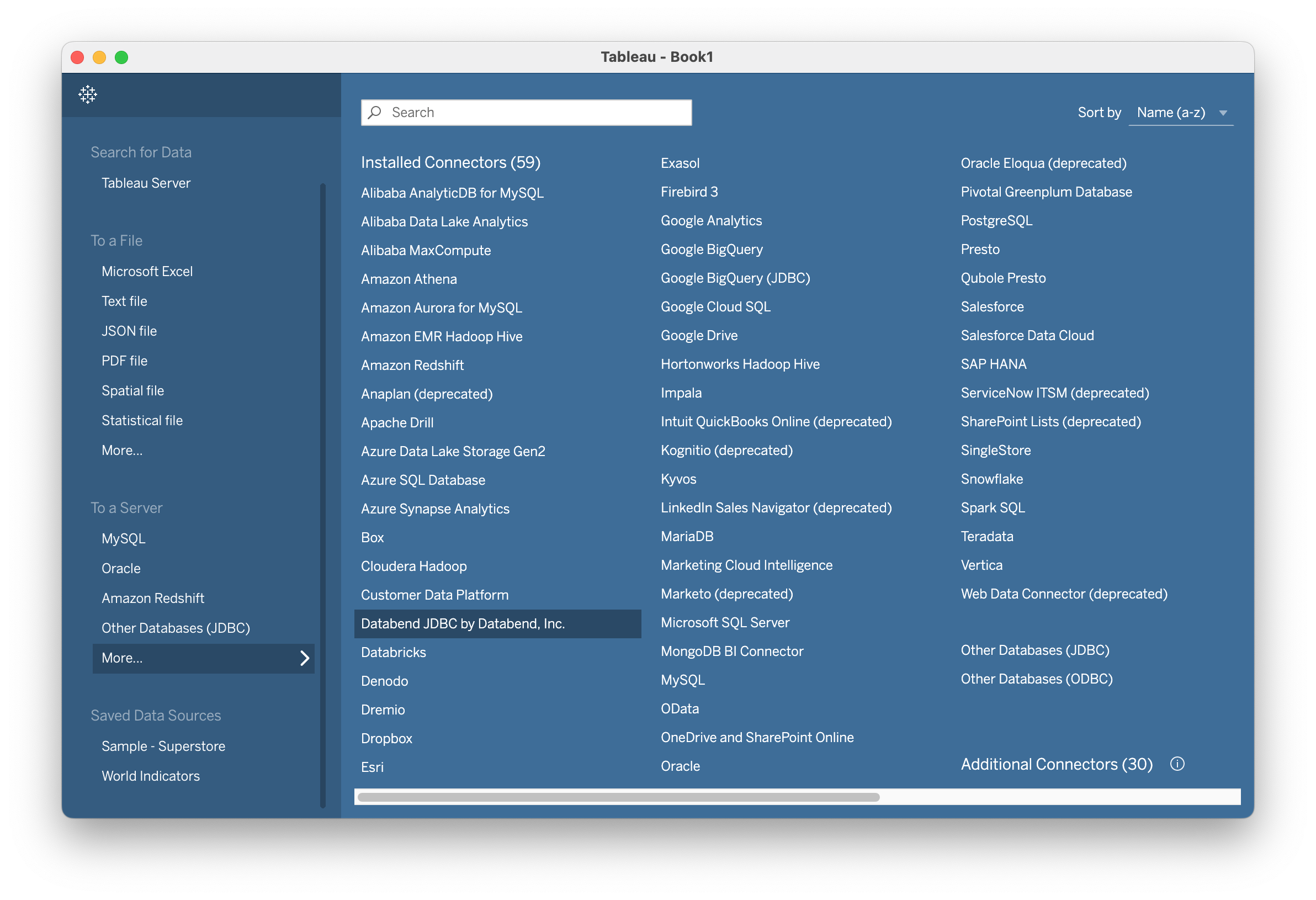
- In the window that opens, provide the connection information and click Sign In.

- Select a database, then you can drag tables to the work area to start your query and further analysis.
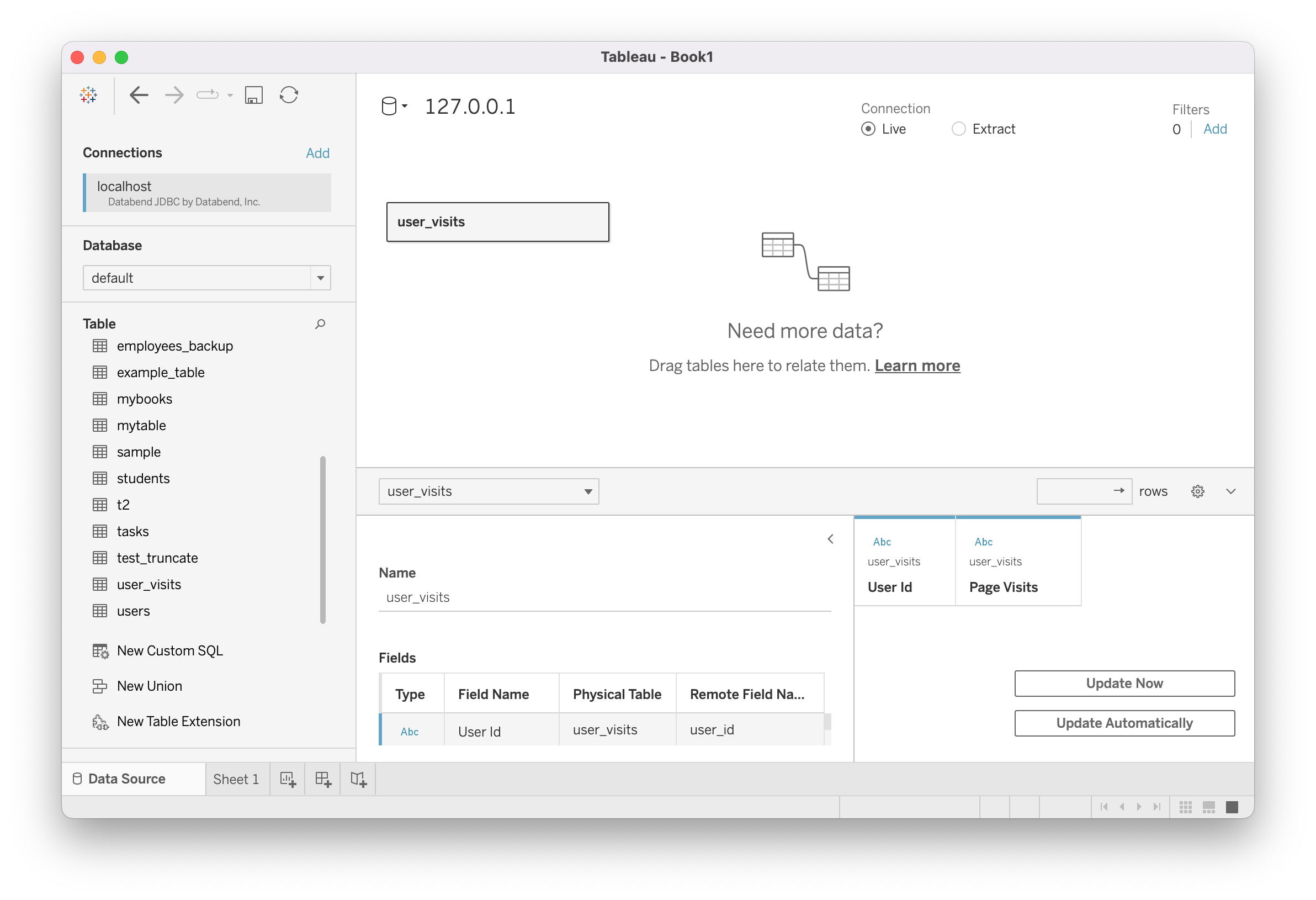
Tutorial 3: Integrating with Databend Cloud
In this tutorial, you'll integrate Databend Cloud with Tableau Desktop. Before you start, download Tableau Desktop and follow the on-screen instructions to complete the installation.
Step 1. Obtain Connection Information
Obtain the connection information from Databend Cloud. For how to do that, refer to Connecting to a Warehouse.
Step 2. Install databend-jdbc
-
Download the databend-jdbc driver (version 0.3.4 or higher) from the Maven Central Repository at https://repo1.maven.org/maven2/com/databend/databend-jdbc/
-
To install the databend-jdbc driver, move the jar file (for example, databend-jdbc-0.3.4.jar) to Tableau's driver folder. Tableau's driver folder varies depending on the operating system:
| Operating System | Tableau's Driver Folder |
|---|---|
| MacOS | ~/Library/Tableau/Drivers |
| Windows | C:\Program Files\Tableau\Drivers |
| Linux | /opt/tableau/tableau_driver/jdbc |
Step 3. Connect to Databend Cloud
- Launch Tableau Desktop and select Other Database (JDBC) in the sidebar. This opens a window as follows:

- In the window, provide the connection information you obtained in Step 1 and click Sign In.
| Parameter | Description | For This Tutorial |
|---|---|---|
| URL | Format: jdbc:databend://{user}:{password}@{host}:{port}/{database} | jdbc:databend://cloudapp:<your-password>@https://<your-host>:443/default |
| Dialect | Select "MySQL" for SQL dialect. | MySQL |
| Username | SQL user for connecting to Databend Cloud | cloudapp |
| Password | SQL user for connecting to Databend Cloud | Your password |
- When the Tableau workbook opens, select the database, schema, and tables that you want to query. For this tutorial, select default for both Database and Schema.
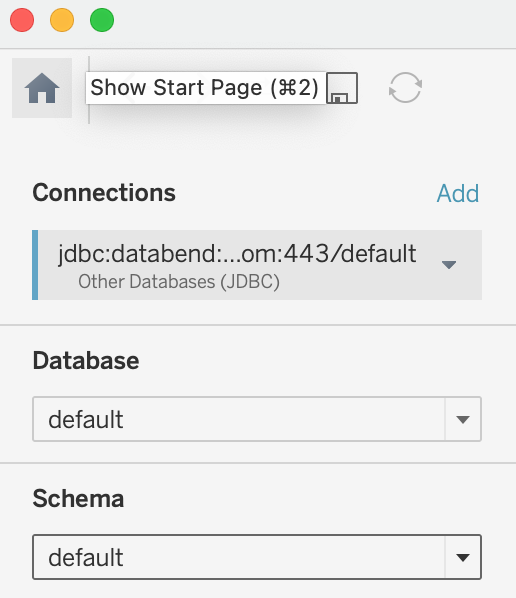
You're all set! You can now drag tables to the work area to start your query and further analysis.